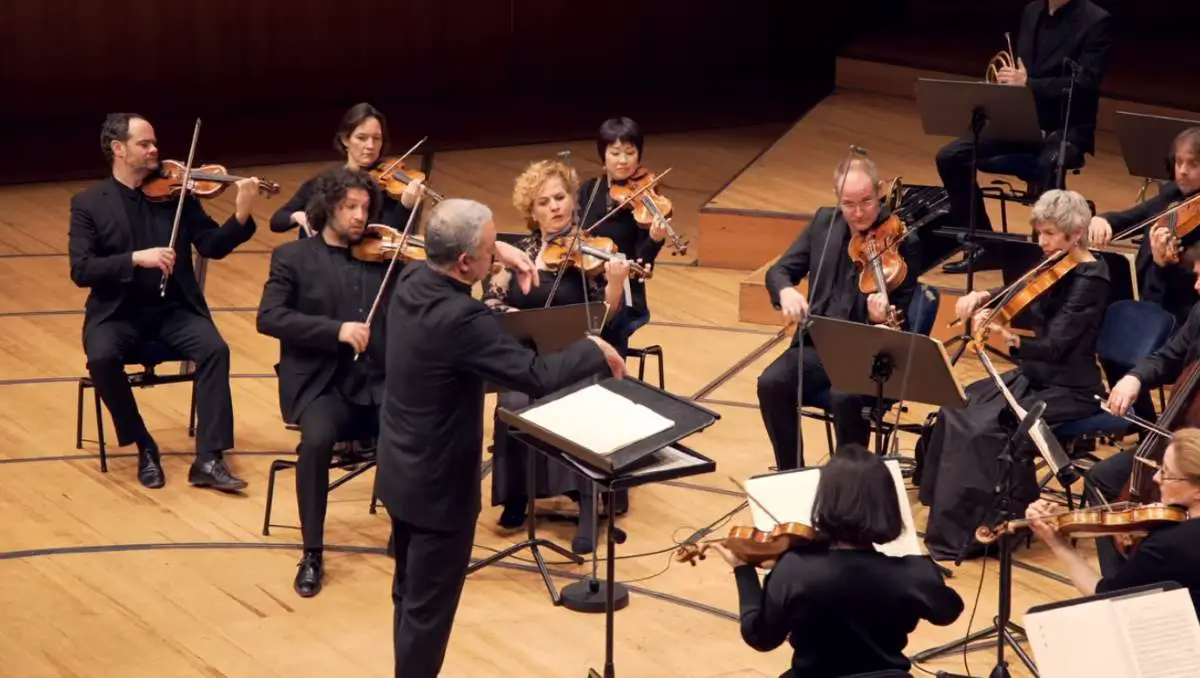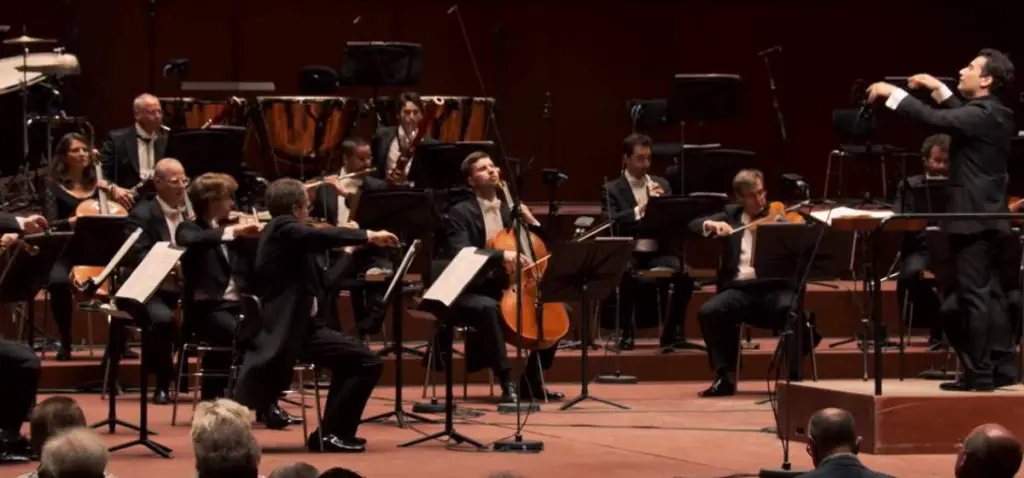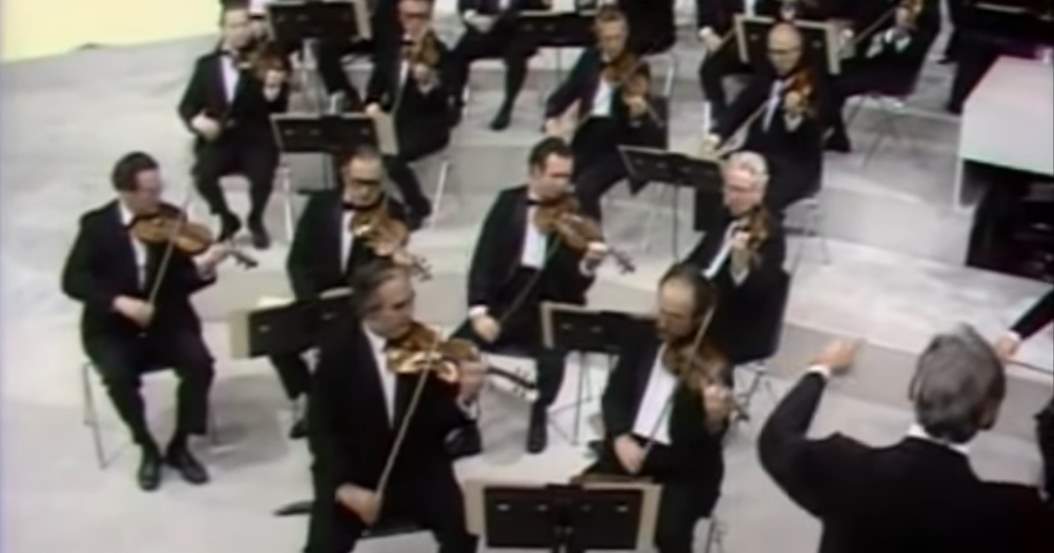Conducted by Frans Brüggen, Dutch early music orchestra The Orchestra of the Eighteenth Century (Dutch: Orkest van de Achttiende Eeuw) plays Wolfgang Amadeus Mozart’s Symphony No. 40 in G minor, KV. 550.
Wolfgang Amadeus Mozart’s Symphony No. 40
Mozart’s Symphony No. 40 in G minor, K. 550, composed in 1788, stands as one of his most emotionally profound and harmonically adventurous symphonies. This work is one of only two symphonies Mozart composed in a minor key, highlighting a striking shift from his typically bright and elegant style. The choice of G minor, often associated with sorrow and turbulence in classical music, allows for an expression of complex, deep emotion, offering a stark contrast to his previous symphonies. Written during a time of personal and financial hardship, the symphony seems to mirror Mozart’s struggles, yet it transcends them with a refined and controlled intensity.
The instrumentation of Symphony No. 40 is relatively lean, lacking the trumpets and timpani commonly used in orchestral works of the time. Originally scored for flute, two oboes, two bassoons, two horns, and strings, Mozart later added clarinets in a revised version, deepening the orchestral texture and enhancing its dramatic potential. The use of clarinets added an expressive warmth and contributed to a more blended and melancholic sound, a rarity in Mozart’s orchestration choices up to that point. This textural balance between woodwinds and strings is one of the symphony’s defining features, drawing listeners into a complex emotional landscape.
Symphony No. 40 is celebrated for its innovative harmonic progressions and developmental techniques. Mozart weaves together melodies with subtle chromatic shifts, creating a musical tension that pushes the boundaries of Classical form. The symphony’s intensity is further enhanced by frequent dynamic changes and syncopated rhythms, which contribute to a feeling of urgency and restlessness. While the structure follows the traditional sonata form, Mozart’s thematic development and harmonic explorations foreshadow elements of the Romantic era, hinting at the emotional depth that would come to characterize later symphonic writing.
Since its composition, Symphony No. 40 has captured the imagination of audiences and composers alike, becoming one of Mozart’s most influential works. Its emotional depth, innovative use of harmony, and dramatic tension set it apart as a masterpiece that invites listeners into a profound musical journey. Today, this symphony remains a favorite in concert halls worldwide, celebrated for its lyrical beauty, formal mastery, and haunting introspection that resonates as powerfully today as it did in Mozart’s time.
Completed on 25 July 1788, the composition occupied an exceptionally productive period of just a few weeks in 1788, during which time he also completed the 39th and 41st symphonies (26 June and 10 August, respectively). It is sometimes referred to as the “Great G minor Symphony,” to distinguish it from the “Little G minor Symphony,” No. 25. The two are the only extant minor key symphonies Mozart wrote.
Movements
The work is in four movements, in the usual arrangement for a classical-style symphony (fast movement, slow movement, minuet, fast movement):
1. Molto allegro, 2/2
The first movement of Mozart’s Symphony No. 40 in G minor, marked Molto allegro, is a powerful and dynamic opening that immediately sets a dramatic tone. Written in 2/2 time, the movement employs a sonata-allegro form, opening with an iconic, restless theme introduced by the strings. This theme, characterized by its quick, syncopated rhythms and descending half-step pattern, evokes a sense of urgency and unease, effectively capturing the somber character of G minor. The melody is simple yet emotionally charged, a reflection of Mozart’s mastery in using minimal motifs to convey complex emotions.
The movement begins darkly, not with its first theme but with accompaniment, played by the lower strings with divided violas. The technique of beginning a work with an accompaniment figure was later used by Mozart in his last piano concerto (Piano Concerto No. 27, KV. 595) and later became a favorite of the Romantics (examples include the openings of Mendelssohn’s Violin Concerto and Sergei Rachmaninoff’s Third Piano Concerto).
As the movement unfolds, Mozart skillfully develops this theme, introducing contrasting motifs that heighten the tension and complexity of the music. The interplay between the strings and woodwinds creates a layered texture, with woodwinds echoing or responding to the strings in an almost conversational manner. Chromatic shifts and unexpected harmonic progressions add to the sense of instability, drawing the listener into an intense, almost dramatic narrative.
The development section further explores the initial theme, fragmenting and reassembling it across different tonalities, which gives the music a feeling of agitation and transformation. As the movement progresses toward the recapitulation, Mozart reintroduces the main theme with added urgency, underscoring the unresolved tension. The movement closes without a clear resolution, emphasizing the symphony’s overall mood of introspection and mystery. This restless opening movement is celebrated for its emotive depth and is often seen as one of Mozart’s most intense symphonic statements, blending Classical clarity with a foretaste of Romantic intensity.

2. Andante, 6/8
The second movement of Mozart’s Symphony No. 40 in G minor, marked Andante and set in a lilting 6/8 time, provides a serene but introspective contrast to the dramatic opening. Its tempo and meter create a gentle, flowing rhythm, giving the impression of calmness. However, beneath this outward tranquility lies a subtly woven tension, as Mozart employs minor-key harmonies and chromatic shifts that keep the listener in a state of quiet suspense. This tension, balanced with moments of delicate beauty, creates an atmosphere of melancholy and introspection that is both soothing and unsettling.
The movement opens with a simple, graceful theme introduced by the violins, which gradually unfolds with variations. Mozart achieves a rich texture by layering the melody with warm woodwind harmonies and echoing phrases, creating an intimate dialogue between the strings and winds. Despite the movement’s seemingly straightforward melody, Mozart’s use of harmonic exploration gives it an underlying complexity, where unexpected minor turns and syncopated rhythms gently disrupt the flow.
As the movement progresses, Mozart introduces contrasting motifs, exploring different tonal regions and adding layers of subtle dissonance. The central development section reflects this intricate balance, with fragments of the main theme reappearing and undergoing transformations. Rather than resolving completely, the music circles back to the original theme in a softer, more contemplative manner, closing the movement with a sense of wistful beauty. This understated complexity in the Andante enhances the symphony’s emotional depth, inviting the listener to experience a reflective, bittersweet calm amid the stormier outer movements.
3. Menuetto. Allegretto-Trio, 3/4
The third movement of Mozart’s Symphony No. 40, marked Menuetto – Allegretto, is set in 3/4 time and combines the structure of a minuet with an intensity that breaks from the traditional elegance associated with dance movements. Although a minuet typically has a light, graceful quality, this Menuetto stands out for its assertive and somewhat dark character. The movement begins with a bold, rhythmic theme in G minor, marked by strong accents and dissonant intervals that lend it a driving force. This forceful melody contrasts sharply with the more lyrical, subdued quality of the preceding Andante, reintroducing a sense of urgency and tension.
Mozart’s use of syncopation and abrupt dynamic shifts within the Menuetto adds to the movement’s intensity, with the theme passing between strings and winds in a tight interplay that emphasizes the movement’s minor-key tonality. The contrasts in dynamics and rhythmic accents create an energetic tension, giving the music an almost stormy quality that feels unexpected for a minuet.
In the central Trio section, Mozart shifts to the relative major key, B-flat major, introducing a warmer and more fluid character. Here, the mood softens as the melody flows with a smoother, almost pastoral quality, offering a brief respite from the movement’s initial vigor. The Trio is simpler and more lyrical, creating a striking contrast with the surrounding sections. After this brief shift, the Menuetto theme returns, restoring its intense character and rounding off the movement with an assertive, yet unresolved, conclusion. This blend of intensity and contrast makes the Menuetto an emotionally complex movement, foreshadowing the dramatic close of the symphony. This minuet is a far cry from the calm gentle minuet of Eine Kleine Nachtmusik.
4. Finale. Allegro assai, 2/2
The fourth movement of Mozart’s Symphony No. 40, titled Finale – Allegro assai, and set in 2/2 time, is a vigorous and intense conclusion that brings the symphony full circle with an outpouring of energy. Opening with a rapid, swirling motif in the violins, the theme captures an almost breathless urgency that feels both thrilling and unsettling. The movement is written in sonata form, and its primary theme is characterized by syncopated rhythms and driving dynamics that add to the restless, almost stormy mood. This energetic motif, combined with a relentless pace, creates an impression of forward momentum that keeps the listener captivated.
As the movement develops, Mozart introduces contrasting themes that add layers of complexity, yet the darker undertones remain. The second theme, while somewhat calmer, is no less intense and contributes to the movement’s overall tension. Throughout, Mozart employs chromaticism and unexpected harmonic shifts that give the music an almost turbulent, anticipatory quality, pushing the boundaries of Classical form and foreshadowing the emotional depth of the Romantic era.
In the development section, Mozart fragments the main theme, exploring various tonalities that heighten the movement’s suspense and instability. When the recapitulation brings back the primary theme, it feels even more urgent, as though the tension of the movement has accumulated. The finale closes in a way that feels unresolved, ending the symphony on a dark, ambiguous note rather than a triumphant conclusion. This choice reflects the symphony’s overall emotional depth and leaves listeners with a sense of lingering intensity and introspection, capturing Mozart’s genius for marrying formal precision with profound expressiveness.
The Orchestra of the Eighteenth Century
The Orchestra of the Eighteenth Century (Dutch: Orkest van de Achttiende Eeuw) is a Dutch early music orchestra. Frans Brüggen and Sieuwert Verster co-founded the orchestra in 1981. Although he did not have a formal title with the orchestra, Brüggen served as the de facto principal conductor of the orchestra from its founding until his death in 2014. Verster has served as the orchestra’s manager since its founding.

Franciscus (“Frans”) Jozef Brüggen (30 October 1934 – 13 August 2014) was a Dutch conductor, recorder player, and baroque flautist. He is considered among the foremost experts in the performance of eighteenth-century music. At the age of 21, he was appointed professor at the Koninklijk Conservatorium Den Haag and later held the position of Erasmus Professor at Harvard University and Regent’s Professor at the University of Berkeley, making him one of the youngest musical scholars of the time.
Sources
- Symphony No. 40 (Mozart) on Wikipedia
- Orchestra of the Eighteenth Century on Wikipedia
- Frans Brüggen on Wikipedia
- “Mozart: Symphony No. 40 in G Minor, K. 550” on the Encyclopedia Britannica website
- “Mozart – Symphony No. 40 in G minor” on the Classic FM website
- “Mozart: Symphony No. 40 in G minor” on the Classic Cat website

